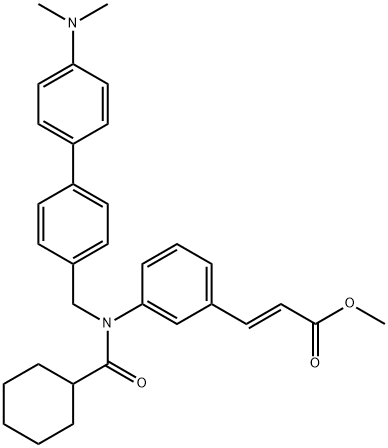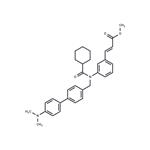Description
The farnesoid X receptor (FXR) is a nuclear receptor that acts as a bile acid sensor, protecting cells and organs against bile acid toxicity and coordinating cholesterol metabolism, lipid homeostasis, and absorption of dietary fats and vitamins. Fexaramine is an FXR agonist (EC
50 = 25 nM) that demonstrates 100-fold increased affinity to FXR compared to endogenous bile acids and 3-fold increased potency compared to the high affinity FXR agonist GW 4064 (; EC
50 = 80 nM). Fexaramine does not display activity at the following nuclear receptors: hRXRα, hPPARαγδ, mPXR, hPXR, hLXRα, hTRβ, hRARβ, mCAR, mERRγ, or hVDR.
Uses
Fexaramine has been used to study its action on RANKL (receptor activator of nuclear factor-κB ligand)-induced osteoclastogenesis in mouse model.
Definition
ChEBI: Fexaramine is a member of biphenyls.
General Description
Fexaramine belongs to the nuclear hormone receptor family.
Biological Activity
Potent, selective farnesoid X receptor agonist (EC 50 = 25 nM). Displays no activity at hRXR α , hPPAR α , hPPAR γ , hPPAR δ , mPXR, hPXR, hLXR α , hTR β , hRAR β , mCAR, mERR γ and hVDR receptors.
Biochem/physiol Actions
Fexaramine might regulate lipid and glucose metabolism and can serve as a therapeutic target in the treatment of fatty liver disease, type 2 diabetes and obesity. Fexaramine might mediate cholesterol homeostasis and promotes osteoblast differentiation and suppresses differentiation of osteoclast.
storage
Desiccate at +4°C



